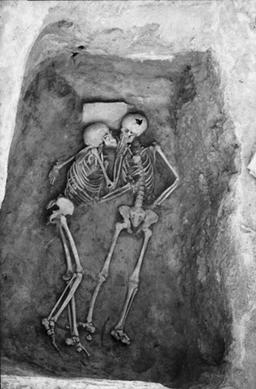Hasanlu Lovers

The Hasanlu Lovers are a pair of human remains found at the Teppe Hasanlu archaeological site, located in the Solduz Valley in the West Azerbaijan Province of Iran, in 1972 by a team from the University of Pennsylvania led by Robert H. Dyson.[1][2] The skeletons have been the subject of debate since they were first excavated.[3][4] They were exhibited at the Penn Museum from 1974 until the mid-1980s.[5]
The two human skeletons were found together in a bin during excavations, seemingly embracing at the time of death.[3] Approximately 246 skeletons were found at the site altogether.[6]
The skeleton on the right (referred to as SK 335) is lying on its back. Dental evidence suggest SK 335 was a young adult, possibly 19–22 years of age. Researchers identified the skeleton as male largely based on the pelvis. The skeleton had no apparent evidence of disease or healed lifetime injuries.[1][2][3]
The skeleton on the left (SK 336) is lying on its left side facing SK 335. It has been aged to about 30–35 years. While sex determination is less definitive for this skeleton, evidence suggests SK 336 was also male. The individual appeared to have been healthy in life, and the skeleton had no apparent evidence of healed lifetime injuries.[1][2][3] At the time of excavation, this skeleton was originally identified as female.[4]
The pair of skeletons were found in a bin-like structure with no other objects except a stone slab under the head of one skeleton.[7] They died together around 800 BCE, during the last destruction of the Hasanlu.[3] Both skeletons lack evidence of injury near the time of death and possibly died of asphyxiation.[4]
Isotopic signatures indicate that the diets of the residents of Hasanlu were varied, including wheat, barley, sheep and goats, and that the residents of Hasanlu were largely born and raised in the area.[8]
Some researchers argue sensationalism about the Hasanlu Lovers and other potential examples of non-heteronormative behaviors in the past are problematic.[9][10]
See also[]
- Embracing Skeletons of Alepotrypa
- Lovers of Valdaro
- Lovers of Cluj-Napoca
- Lovers of Modena
- Lovers of Teruel
References[]
- ^ a b c Dandamaev, M. A. (1989). The Culture and Social Institutions of Ancient Iran. Cambridge; New York City: Cambridge University Press. ISBN 978-0521321075.
- ^ a b c Dyson, Jr., Robert H. (1973). "Survey of Excavations in Iran 1971–72". Iran: Journal of the British Institute of Persian Studies. 11: 195. JSTOR 4300498.
- ^ a b c d e "The Lovers - Hasanlu". Penn Museum. Retrieved 31 October 2017.
- ^ a b c Muscarella, Oscar White (31 July 2013). Koehl, Robert B. (ed.). Amilla: The Quest for Excellence. Studies Presented to Guenter Kopcke in Celebration of His 75th Birthday. INSTAP Academic Press (Institute for Aegean Prehistory). doi:10.2307/j.ctt5vj90s.30. ISBN 978-1-62303-313-2.
- ^ "Gazette: Changing Times: 1961-1981 (July/August 2002)". www.upenn.edu. Retrieved 3 August 2020.
- ^ Muscarella, Oscar W. "Warfare at Hasanlu in the Late 9th Century B.C." Expedition Magazine 31.23 (1989): Expedition Magazine. Penn Museum, 1989 Web. 31 Jul 2020 http://www.penn.museum/sites/expedition/?p=2478
- ^ Ellsworth, Amy. "Penn Museum Blog". Penn Museum. p. 20. Retrieved 12 October 2014.
- ^ Toebbe, Diana Smay (2005). "Measurement of inclusion biases in archaeological skeletal collections: A case study of Hasanlu". ISBN 978-0-542-15412-6. Cite journal requires
|journal=(help) - ^ Snoddy, Anne Marie E.; Beaumont, Julia; Buckley, Hallie R.; Colombo, Antony; Halcrow, Siân E.; Kinaston, Rebecca L.; Vlok, Melandri (1 March 2020). "Sensationalism and speaking to the public: Scientific rigour and interdisciplinary collaborations in palaeopathology". International Journal of Paleopathology. 28: 88–91. doi:10.1016/j.ijpp.2020.01.003. ISSN 1879-9817.
- ^ Killgrove, Kristina (8 April 2017). "Is That Skeleton Gay? The Problem With Projecting Modern Ideas Onto The Past". Forbes. Retrieved 31 July 2020.
- 1972 archaeological discoveries
- Archaeology of death
- Archaeology of Iran
- Burial monuments and structures
- Couples
- Death in Iran
- Human remains (archaeological)
- Same-sex couples
- Skeletons
- Teppe Hasanlu
- University of Pennsylvania Museum of Archaeology and Anthropology
- West Azerbaijan Province
- Iran stubs
- Near East archaeology stubs